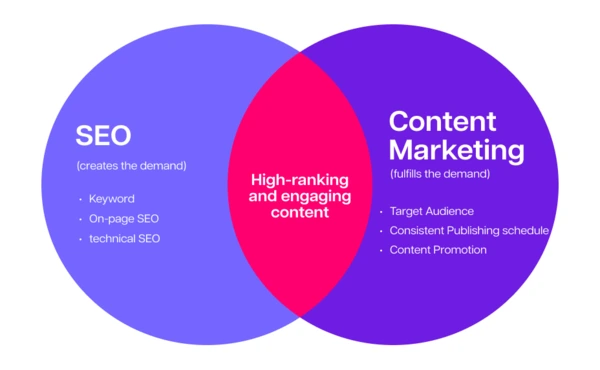
Standing out from the crowd needs a focused, data-driven strategy. Content marketing and SEO (Search Engine Optimization) have become known as important components for businesses seeking to increase visibility, build authority, and successfully reach their target audience. Companies can create a strong foundation for their long-term growth through using content marketing strategies and SEO, improving their online presence and providing quality material that attracts and retains customers. This article discusses how content marketing and SEO can improve digital marketing efforts, as well as how technologies like 360 Marketing Tool can help with these goals.
What is content marketing?
Content marketing is the process of creating, publishing, and sharing online content (ranging from blogs and videos to ebooks and podcasts).
This content was not created to sell products or promote a brand, but rather to educate, entertain, or empower potential customers. This gradually builds their attention, engagement, and trust, finally creating customer conversion.
Role of Content Marketing
Content marketing is the strategic creation and distribution of valuable, relevant, and consistent content with the goal of engaging and retaining a target audience. This information, whether in the form of blog articles, videos, infographics, or social media posts, helps to develop trust, establish authority, and carefully guide prospects toward a purchase decision.
Statistics show the effectiveness of a strong content strategy. Recent research shows that companies that blog regularly generate 67% more leads than those that do not. Companies that produce 16 or more blog articles per month receive 3.5 times more traffic than those who write less than four posts. With a large percentage of consumers finishing internet research before making a purchase, having relevant content that answers their queries and addresses their pain points is important.
What is SEO?
SEO, or search engine optimization, is the process of optimizing and upgrading your website (and its content) so that it shows up in search results when people look for information, answers, products, or services.
how it is important these days to be found in search engines, particularly Google. Google search, images, and maps account for 92.96% of global traffic. If your website and pages score high in search results, you'll get a good part of that.
How SEO Improves Content Marketing
SEO is the method of optimizing content so that search engines such as Google can understand and rank it in response to relevant requests. It involves a variety of strategies, including keyword research, on-page SEO (optimizing titles and meta descriptions), and technical SEO (site speed and mobile friendliness).
One of the main benefits of integrating SEO and content marketing is that it ensures that information reaches a deeper, more targeted audience. According to research, 93% of all online experiences begin with a search engine, with Google's initial result receiving around 27.6% of all clicks. This underlining performs well in search engines since it greatly improves the possibility of being seen by potential customers.
Content optimized for SEO also has a long lifespan; unlike sponsored ads, which stop driving traffic after the budget ends, high-quality SEO content can continue to generate organic traffic for months, if not years. Businesses that continuously produce SEO-friendly content create a good valuable resource that can attract and convert visitors over time.
Effective Strategies for Content Marketing and SEO

Creating an effective digital presence needs the use of content marketing and SEO. When these techniques work together, they can produce long-term effects, including increase the brand visibility to high-quality leads. Here are some of the most effective ways for improving your content marketing and SEO efforts to produce impactful, engaging, and highly ranked content.
Data-Driven Keyword Research
Keyword research is an important component of both SEO and content marketing. It is not sufficient just to find high-volume keywords; you must also select keywords that match your target audience's intent and are relevant to their needs.
Identify high-intent keywords: These keywords reflect what your target audience is actively looking for and can help convert readers into customers.
Use long-tail keywords: Long-tail keywords are specific phrases with lower search volume but higher intent. These keywords are typically less competitive and more relevant for specific audiences.
Create High-Quality Content
Quality is the backbone of any successful content marketing strategy. Search engines prioritize content that is helpful, informative, and relevant to users.
Focus on your audience's needs: To produce content that engages with your target audience, first understand their pain points, difficulties, and interests.
Use various content formats: Explore with numerous content types, including blog posts, videos, infographics, podcasts, and case studies, to engage consumers with various opinions.
Keep it evergreen: Evergreen content, or content that remains relevant over time, attracts visitors long after it has been published, providing sustained value for SEO.
Optimize On-Page SEO Elements
On-page SEO helps search engines understand and rank your content more efficiently. Optimizing important on-page features helps boost your content's visibility in search engines.
Create engaging titles and meta descriptions: These parts are the first things users see in search results, so make sure they are interesting and include the target keywords.
Use header tags: Organizing the content with header tags (H1, H2, H3, etc.) not only improves readability but also informs search engines about the topics covered.
Include internal and external link: Internal links help people and search engines explore your site, while reliable external links increase credibility and support your content.
Optimize Content for User Experience (UX)
User experience is becoming a more important factor in SEO, as search engines encourage websites that are simple to use and provide an enjoyable visit.
Ensure mobile-friendliness: With over 60% of internet traffic coming from mobile devices, a mobile-friendly site is important.
Prioritize site speed: Slow-loading pages can increase bounce rates, so ensure your site is fast and responsive.
Enhance readability: Break up content into shorter paragraphs, use bullet points, and add visuals to make content easier to read.
Build a Strong Link-Building Strategy
High-quality backlinks are important for SEO because they show to search engines that your content is trustworthy and reliable.
Reach out for guest posting opportunities: Publishing content on trustworthy sites in your niche can increase traffic and backlinks.
Generate shareable content: Backlinks are usually targeted to multimedia content, infographics, and research-based information.
Collaborate with influencers and industry experts: These relationships can help promote your content to a wider audience and build authority through backlinks.
Using 360 Marketing Tool for Content Marketing and SEO
360 Marketing Tool is a set of tools designed for digital marketing success. This platform offers comprehensive services to businesses hoping to boost their content generation and SEO efforts, with the goal of increasing visibility and engagement. From keyword research and content creation to SEO audits and competitive analysis, 360 Marketing Tool simplifies the difficult responsibilities of content marketing and SEO, allowing businesses to achieve more measurable results.
Whether a company is just getting started with digital marketing or wants to fine-tune its strategy, solutions like 360 Marketing Tool give the resources and insights required to speeds up the process, connect with best practices, and remain ahead of competition.
Conclusion
Content marketing and SEO are important parts of any modern digital marketing strategy. Businesses that create excellent, optimized content may increase visibility, attract the correct audience, and develop leads along the sales funnel. Brands may develop a long-term competitive by taking a strategic approach to content and using SEO. Take your SEO to the next level, Check out our blog A Step-by-Step Guide for SEO Success
What to read next

